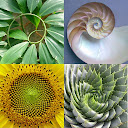Bosquejo de la prueba: Vamos a Γ≤Iso(R2) ser un fondo de pantalla de grupo. A continuación, Γ tiene normalmente un subgrupo isomorfo
a Z2 con un límite del cociente de la F. Este finito grupo actúa en el entramado Z2 por conjugación.
Podemos obtener una representación fiel
F↪Aut(Z2)≅GL2(Z).
El grupo GL2(Z) tiene exactamente 13 diferentes clases conjugacy de subgrupos finitos,
llama la aritmética adorno clases:
C1≅⟨(1001)⟩,C2≅⟨(−100−1)⟩,C3≅⟨(01−1−1)⟩,C4≅⟨(01−10)⟩,C6≅⟨(01−11)⟩,D1≅⟨(100−1)⟩,D1≅⟨(0110)⟩,D2≅⟨(100−1),(−100−1)⟩,D2≅⟨(0110),(−100−1)⟩,D3≅⟨(0110),(01−1−1)⟩,D3≅⟨(0−1−10),(01−1−1)⟩,D4≅⟨(0110),(01−10)⟩,D6≅⟨(0110),(01−11)⟩.
Este es un sencillo cálculo. Aquí C1,C2,C3,C4,C6 son cíclicos grupos y D1,D2,D3,D4,D6 son diedro grupos. Utilizamos aquí, que la orden de n de un subgrupo debe satisfacer ϕ(n)=deg(Φn)∣2, por lo que n=1,2,3,4,6. Este es el llamado cristalográficos de la condición. El fondo de pantalla de los grupos surgen a partir de estos 13 clases de clases de equivalencia de extensiones
1→Z2→Γ→F→1,
determinado por H2(F,Z2).
Mediante el cálculo de H2(F,Z2) en cada caso obtenemos 18 no equivalentes extensiones, porque en 13 de los casos la cohomology es trivial, y en tres casos se obtiene C2,C2 e C2×C2, es decir, 5 de posibilidades adicionales, de modo que 13+5=18.
Este rendimientos 17 diferentes grupos, debido a que dos de ellos resultan ser isomorfos.


